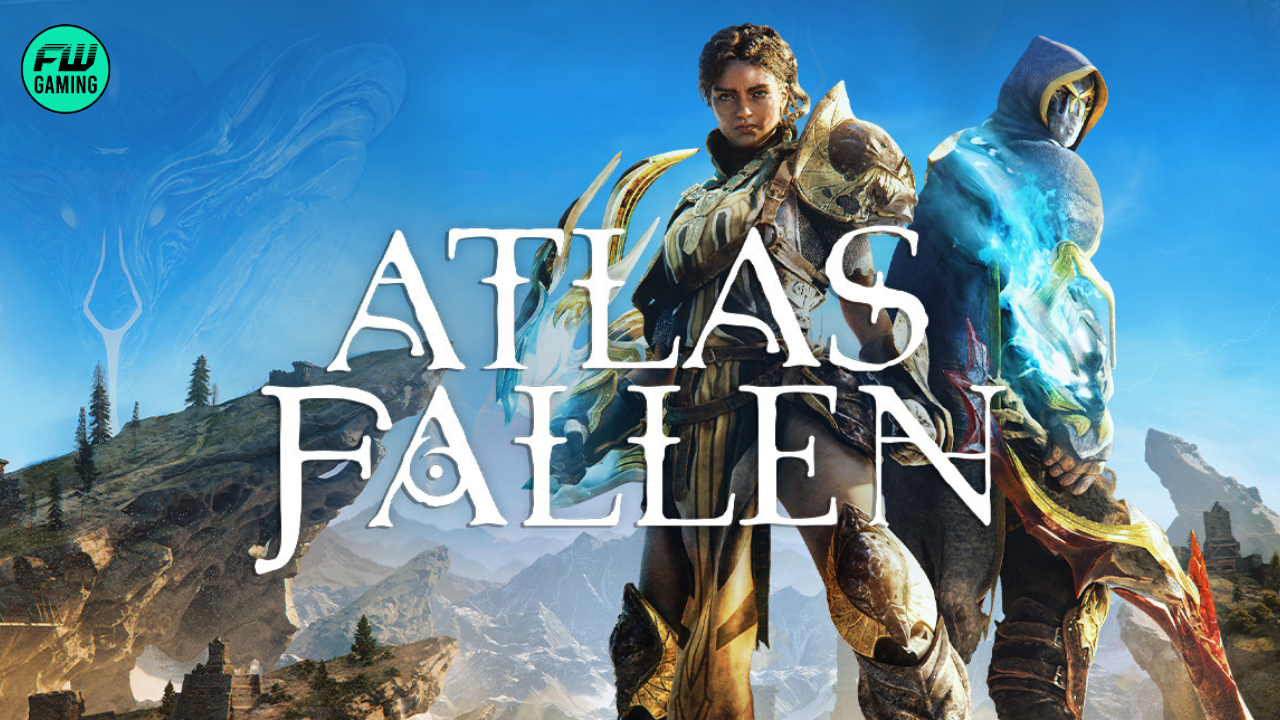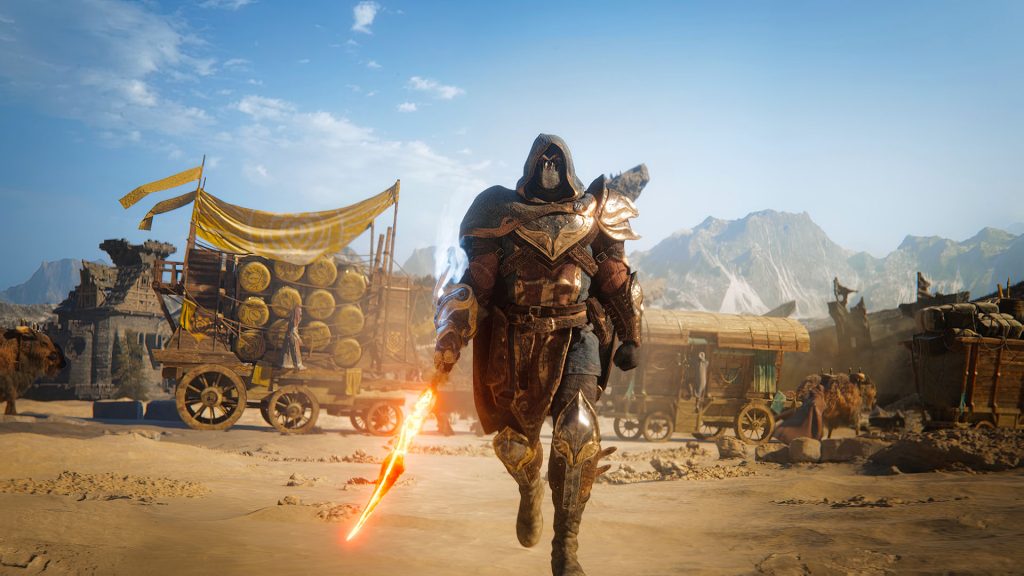We took some time out of our hectic Gamescom 2023 schedule and spoke to Deck13, the developers behind the excellent Atlas Fallen about co-op, the previous games inspiring their latest outing and much more.
For those unaware, Atlas Fallen is a sand-surfing, fantasy-set, action adventure video game that’ll leave you breathless at the scenery one moment, and then surprised at being surrounded by enemies so quickly and so quietly the next. Throw in a fresh and unique story and you have all the makings of a franchise, but more on that another time.
Related: Atlas Fallen Review: Lord of the Sands (PS5)
Q. Firstly, congratulations on the excellent game! Where did the initial inspiration for the world, lore and the inhabitants start?
Thank you! Atlas Fallen is a hard break with the Sci-Fi setting that we spent multiple years on exploring with the Surge games. So thematically it is entirely different in the inspirations we drew. And they will vary a lot, depending on who you ask. Our Art team, which worked a lot on covering entire levels in sand while still maintaining variety in biomes, would name the planet Arrakis from Frank Herberts’ Dune.
Asking me, given that I’m mainly focused on action-oriented, fast-paced combat and exploration would prompt answers like the world and combat flow of Nier: Automata, the over-the-top combat of Bayonetta and the fluidity and combo focus of Darksiders.
Q. The real beauty is in the details, so what’re you as a team most proud of in Atlas Fallen?
It is difficult to isolate one single element as we worked on so many different aspects throughout the team. But in general, the things we are the most proud of are all the new challenges we took on and managed to overcome. For instance, moving to a much more dynamic and action-oriented combat system, enriching it with a layer of aerial mobility, and developing more open environments while retaining the intricacy that gave personality to the level designs of our previous games.
Q. What lessons from the studio’s previous games were most relevant and important to Atlas Fallen?
As mentioned above, we definitely used a lot of our knowledge in crafting intricate environments which we acquired from our previous games. Said games also locked players in a predefined challenging difficulty level. This was core to the experience, but prevented lesser experienced players from getting on board. With Atlas Fallen, along with offering more freedom in exploring the world and figuring out different approaches in tackling objectives, we expanded the accessibility by providing three levels of difficulty, suited for different player profiles.
We also worked a lot on offering a strong game feel and sense of weight to our combat moves, which is a know-how we have sharpened with our past titles. Targeting body parts of enemies also makes a return in Atlas Fallen, which again is an essential part in gathering resources for the character progression.
Finally, the aspect with the strongest lineage is likely the Essence Stones, which are a direct descendant of the Implant system, from which refined this idea of offering players a wide range of meaningful customisation in their build. Based on the reception of this feature in the Surge games, we knew we wanted to build on it and expand on the freedom players get in shaping their characters and approaching the combat encounters.
Q. Atlas Fallen seems to be developed with two players in mind. Is that intentional, or was it later added as an extra gameplay dynamic?
From the very beginning the intention was to make Atlas Fallen a solo game, also entirely playable in cooperation. Therefore, we always thought about the solo experience first and foremost, but always designed with co-op in mind. This in order to make the transition from one to the other seamless and draw the best out of experiencing the adventure with a friend and synergizing with them.
A second player brings up a lot of challenges in development. Designing every cutscene to also work with an additional character in them, triggering events while the co-op partner is on the different side of the map and insanely broken synergies when culminating effects of certain active and passive abilities are just a few examples. Setting cooperative play as a cornerstone of development from day 1 was the only way a team of our size could realistically implement and polish this feature to a level that players would enjoy.
Q. Sand-surfing is immensely fun. Was there ever a time where a different type of transportation was thought of?
For quite some time we only had a basic sprint but realized that we weren’t leveraging the fantasy of mastering the sand to its full potential. That’s when we decided to find a more appealing mode of locomotion on ground and the idea to make it sand-surfing rapidly clicked with the team, which remained as is until release.
We also experimented a lot with the player’s ability to dash through the air. As we wanted to make most of our move-set shared between combat and exploration, we had to find the right middle-ground for heights, distances and speed that would work well for both aspects.
Q. Was there a particular reason the studio took a change of pace from the Soulslike games that they had such success with before?
This was the combination of two factors: we wanted to make our games more accessible to a wider audience and at the same time we felt the need to challenge ourselves with something new, to continue growing as a team and a company. This doesn’t mean we are departing from the Souls-like genre, but rather we are expanding our expertise and experimenting with new types of games.
And on a personal note: It is nice to have crafted a game that is more accessible, and therefore can be shared widely with friends and family who now get a chance to experience what you have been working on for years.
Q. The game had a huge amount of essence stones allowing for a wide variety of gameplay and combat choices, but with some of the better ones ‘locked’ behind the third tier, do you think players will miss out on using them? Linked to this, what was the thought process behind the combat mechanics themselves?
We really designed these essence stones as very powerful and a strong motivation for players to push their momentum higher and higher. But we have balanced momentum in such a way that the first Tier 3 slot should be reachable with a bit of practice, even for the least experienced players. We tinkered a lot based on playtest data and we hope to have found a right balance between challenge and reward here.
As for the general design thought process behind the combat mechanics, our core intention was to make a combo multiplier which contributes actively to the flow of combat. Continuously challenging the player to take more risks for a higher reward and at the same time considering when it is time to cash-in and retreat.
This is essentially what the Momentum is. And the Essence Stones, the Weapon Bolstering and the Shattering are additional tools that add weight, variety and further depth to this core loop. We also made the conscious decision that Momentum is not spent when using these abilities, so players can trigger a Tier 3 move multiple times in a fight once they are unlocked.
Q. What was the hardest part of the game to implement?
There are many contenders to this title! I think the enemy AI and the camera take the lead though.
Developing group behaviors for our wraiths and a camera which can keep up with the player’s mobility and the wide variety of groups and sizes of our enemies were definitely challenging. This was totally out of our comfort zone, as Souls-like games rather focus on one-on-one combat with limited mobility.
And as hinted earlier, co-op also made things more complicated. Every decision had co-op in mind, every addition also needed to work for a second player. It is like creating a second game on the side while always making sure single player gamers never get the feeling that they are missing out on something by playing alone.
Well there we have it, an eye-opening behind-the-scenes introduction of Atlas Fallen. What did you think of the game? Did you enjoy it as much as ourselves? Let us know in the comments!
Follow us for more entertainment coverage on Facebook, Twitter, Instagram, and YouTube.





![Lies of P's Game Director Jiwon Choi Discusses the Game, Disney and the Darker Sides of Pinocchio [EXCLUSIVE]](https://fwmedia.fandomwire.com/wp-content/uploads/2023/09/16134750/lies-1-768x432.png)






